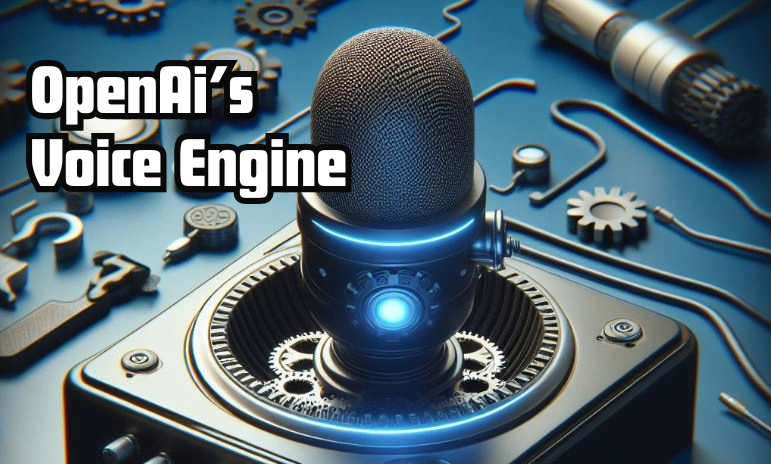The OpenAI Voice Engine is a text-to-speech AI model that can create synthetic voices based on a 15-second segment of recorded audio. This technology allows users to input text and generate AI-generated voice results that closely resemble the original speaker’s voice.
OpenAI with its recent buzz about Sora (text-to-video model), now has developed a Voice Engine to provide various benefits, such as reading assistance, global reach for creators by translating content while preserving native accents, personalized speech options for non-verbal individuals, and aiding patients in recovering their own voice after speech-impairing conditions.
Despite its capabilities, OpenAI has chosen to preview the Voice Engine but not widely release it at this time due to ethical implications and potential misuse concerns. The company is taking a cautious approach to its deployment, emphasizing the need for responsible use of synthetic voices and societal adaptation to this new technology. OpenAI is engaging in small-scale tests and discussions to make informed decisions about the future deployment of the Voice Engine technology at scale.
Picture this: you’re sitting in a cozy café, sipping on your favorite latte, when suddenly, your phone buzzes with a notification. Curious, you glance at the screen to find a message from a loved one. But here’s the twist – the message isn’t in their usual voice. It’s a perfect replica, generated by AI. Welcome to the world of synthetic voices, where technology seamlessly mimics human speech, opening doors to a myriad of possibilities.
How can the Voice Engine be used?
Synthetic voices, powered by cutting-edge AI algorithms, are revolutionizing how we communicate and interact with technology. From personalized voice assistants to immersive storytelling experiences, the applications are as diverse as they are innovative. Let’s take a closer look at some of the key areas where synthetic voices are making waves:
- Personalized Assistance: Imagine having a virtual companion tailored to your unique preferences and personality. Synthetic voices enable the creation of virtual assistants that not only assist with tasks but also engage in natural, human-like conversations.
- Multilingual Communication: Breaking down language barriers has never been easier. Synthetic voices can fluently translate content into multiple languages, opening doors to global communication and collaboration.
- Accessibility Solutions: For individuals with speech impairments or disabilities, synthetic voices offer a lifeline. AAC devices powered by AI can provide non-verbal individuals with the ability to communicate effectively, empowering them to express themselves and engage with the world.
- Enhanced Entertainment: From audiobooks to podcasts, synthetic voices are transforming the entertainment landscape. By bringing characters to life with emotive and expressive speech, AI-driven narration adds a new dimension to storytelling.
Examples of voices generated by OpenAi’s Voice Engine:
These examples just blow away my mind, listen to them carefully. They are as real as it could be.
What Ethical Considerations are Being Made?
While the potential of synthetic voices is undeniably exciting, it also raises important ethical questions and concerns. As we venture into this uncharted territory, it’s crucial to tread carefully and thoughtfully address the following challenges:
- Authenticity and Misuse: With the ability to mimic any voice, synthetic voices blur the line between reality and fabrication. There’s a risk of misuse, including impersonation, misinformation, and manipulation, highlighting the importance of ethical guidelines and safeguards.
- Privacy and Consent: The creation and use of synthetic voices raise privacy concerns, particularly regarding the use of personal data and recordings. It’s essential to prioritize user consent and data protection to ensure responsible AI deployment.
- Cultural Sensitivity: In a globalized world, cultural nuances and sensitivities must be taken into account when developing synthetic voices. Respectful representation and accurate portrayal of diverse voices are key to fostering inclusivity and diversity.
As we navigate the opportunities and challenges of synthetic voices, it’s imperative to adopt a responsible and ethical approach to innovation. Here are some guiding principles to consider:
- Transparency and Accountability: Developers and organizations should be transparent about the use of synthetic voices and ensure accountability for their actions. Clear disclosure and informed consent are essential pillars of responsible AI deployment.
- User Empowerment: Empowering users with control over their data and voices is paramount. Providing tools and options for users to manage and protect their privacy fosters trust and accountability.
- Continuous Evaluation and Improvement: The ethical implications of synthetic voices evolve over time, requiring ongoing evaluation and adaptation. Collaboration between stakeholders, including policymakers, researchers, and industry leaders, is essential for shaping ethical guidelines and standards.
You can check out generated voices in languages other than English on OpenAi’s Voice Engine. It has been used to power preset voices for text-to-speech APIs and features like ChatGPT‘s Read Aloud. Despite its capabilities, OpenAI has not made Voice Engine publicly available but has provided limited access to select partners through pilot programs. These partners have successfully applied Voice Engine to tasks such as generating voiceovers for educational content, translating videos, providing reading assistance, and supporting non-verbal individuals with personalized speech options.






